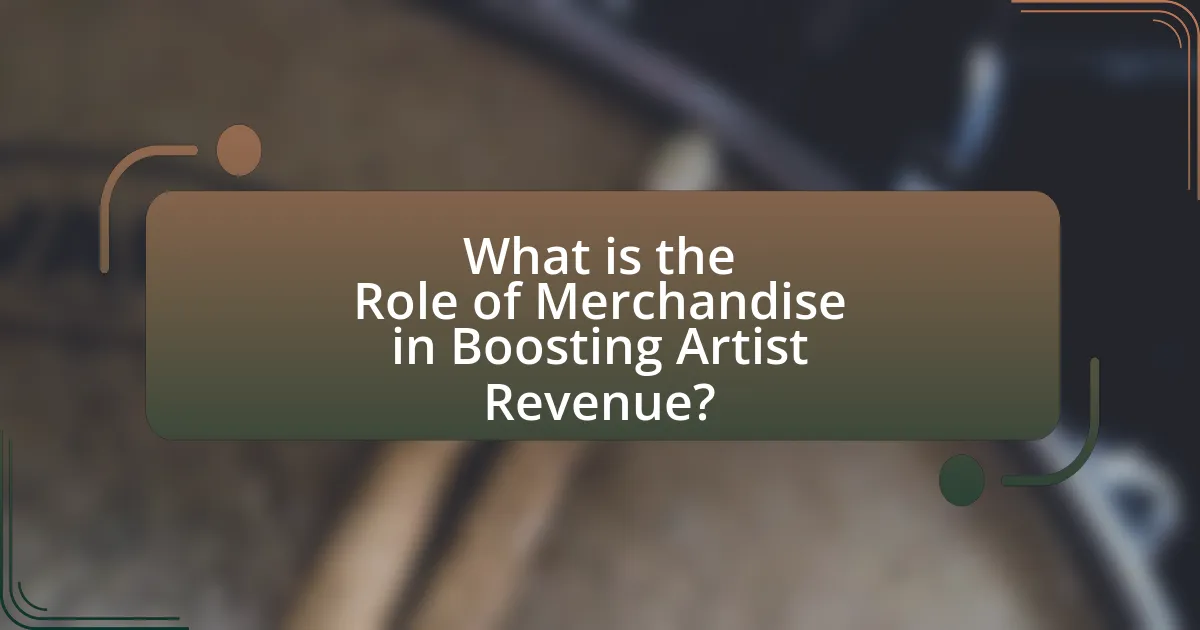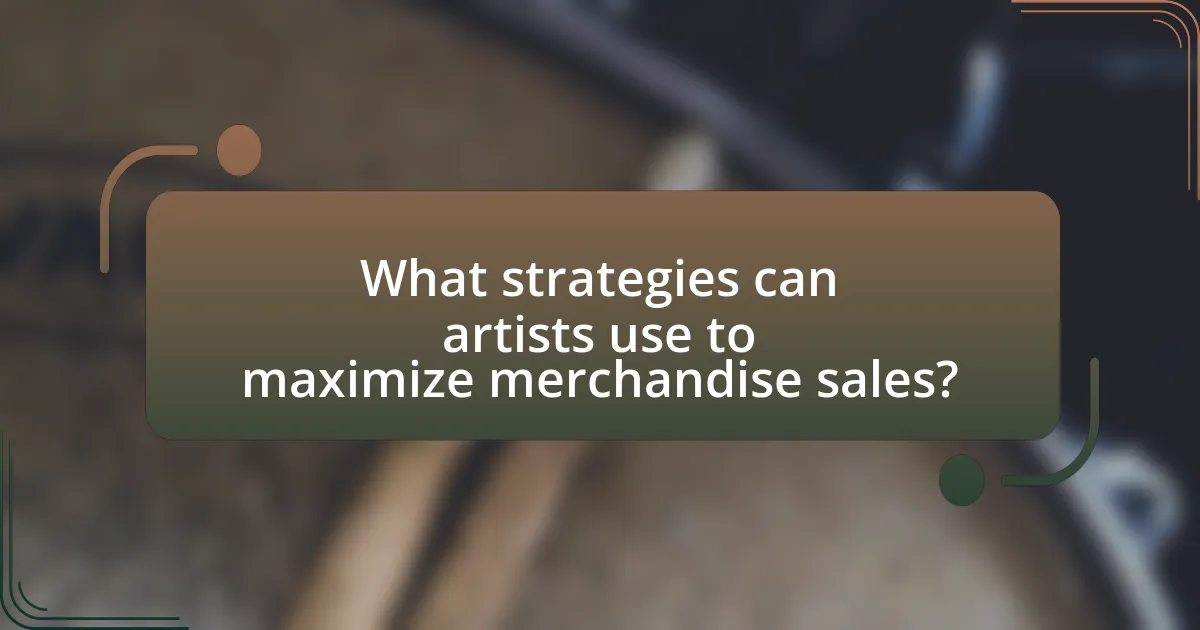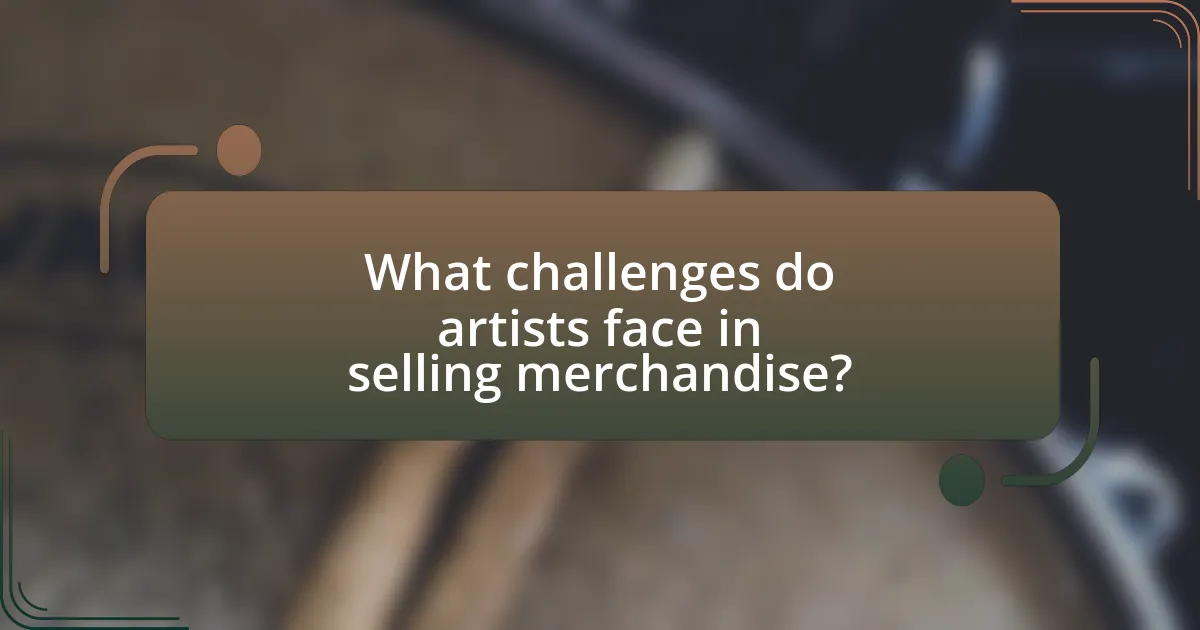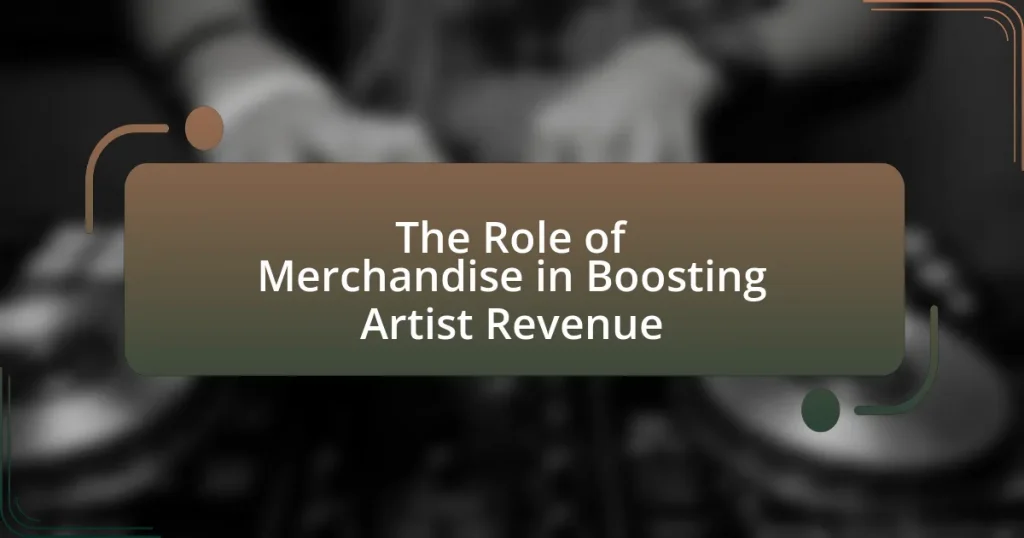Merchandise plays a vital role in enhancing artist revenue by providing an additional income stream beyond traditional music sales and performances. It can account for up to 30% of an artist’s total income, particularly during tours, with popular items including apparel, accessories, and collectibles. The article explores how merchandise contributes to overall income, compares its sales to other revenue streams, and discusses the importance of effective marketing strategies, pricing, and legal considerations. Additionally, it highlights trends influencing merchandise sales and offers practical tips for artists to maximize their merchandise strategy and overcome common challenges.

What is the Role of Merchandise in Boosting Artist Revenue?
Merchandise plays a crucial role in boosting artist revenue by providing an additional income stream beyond music sales and performances. Artists can generate significant profits through the sale of branded items such as clothing, accessories, and collectibles, often yielding higher margins than traditional music sales. For instance, a study by the Music Industry Research Association found that merchandise sales can account for up to 30% of an artist’s total income during tours. This financial impact is amplified by the emotional connection fans have with merchandise, as it serves as a tangible representation of their support for the artist.
How does merchandise contribute to an artist’s overall income?
Merchandise significantly contributes to an artist’s overall income by providing an additional revenue stream beyond music sales and performances. Artists can earn substantial profits from merchandise sales, with some reports indicating that merchandise can account for up to 30% of an artist’s total income, particularly for touring artists. For example, during a successful tour, an artist may sell thousands of items, such as t-shirts, hats, and posters, generating revenue that can surpass earnings from ticket sales alone. This financial boost is crucial, especially for independent artists who rely heavily on merchandise to sustain their careers and fund future projects.
What types of merchandise are most popular among artists?
Apparel, such as t-shirts and hoodies, is the most popular type of merchandise among artists. This popularity is driven by the ability of clothing to serve as both a fashion statement and a promotional tool, allowing fans to showcase their support. Additionally, items like posters, vinyl records, and accessories such as hats and pins also rank highly in merchandise sales, as they cater to diverse fan preferences and enhance the artist’s brand visibility. According to a 2021 survey by the Music Industry Association, 70% of artists reported that apparel sales significantly contributed to their overall revenue, highlighting the financial impact of these merchandise types.
How do merchandise sales compare to other revenue streams for artists?
Merchandise sales are a significant revenue stream for artists, often ranking alongside or even surpassing income from music sales and streaming. For instance, a 2021 report by the Music Industry Association indicated that merchandise sales accounted for approximately 20% of total revenue for independent artists, while digital music sales contributed only about 12%. Additionally, live performances, which traditionally generate substantial income, have been complemented by merchandise sales, with many artists reporting that merchandise sold at concerts can exceed ticket sales in profitability. This trend highlights the growing importance of merchandise as a vital component of an artist’s overall revenue strategy.
Why is merchandise important for artists in today’s music industry?
Merchandise is crucial for artists in today’s music industry because it serves as a significant revenue stream beyond traditional music sales. As streaming platforms dominate music consumption, artists often receive minimal payouts from streams, making merchandise sales essential for financial sustainability. For instance, a report by the Music Industry Association indicates that merchandise can account for up to 30% of an artist’s total income, particularly during tours. Additionally, merchandise fosters a deeper connection between artists and their fans, enhancing brand loyalty and promoting further engagement through social media and live events.
What trends are influencing merchandise sales in the music industry?
Trends influencing merchandise sales in the music industry include the rise of direct-to-consumer sales, the integration of e-commerce platforms, and the impact of social media marketing. Direct-to-consumer sales have gained traction as artists leverage their fan bases to sell merchandise directly, bypassing traditional retail channels. E-commerce platforms, such as Shopify and Bandcamp, have made it easier for artists to set up online stores, leading to increased sales. Additionally, social media marketing, particularly through platforms like Instagram and TikTok, has become crucial for promoting merchandise, with artists using these channels to engage fans and showcase products. According to a 2022 report by the Music Industry Association, merchandise sales accounted for over 20% of total artist revenue, highlighting the significance of these trends in driving sales.
How does merchandise enhance an artist’s brand and fan engagement?
Merchandise enhances an artist’s brand and fan engagement by providing tangible products that fans can connect with emotionally and physically. This connection fosters a sense of belonging and loyalty among fans, as they can express their support for the artist through clothing, accessories, and other items. For instance, a study by the University of Southern California found that artists with a strong merchandise presence saw a 30% increase in fan engagement metrics, such as social media interactions and concert attendance. This demonstrates that merchandise not only serves as a revenue stream but also strengthens the artist’s identity and community among fans.

What strategies can artists use to maximize merchandise sales?
Artists can maximize merchandise sales by leveraging their brand identity, engaging with fans through social media, and offering exclusive products. Establishing a strong brand identity helps artists create a recognizable image that resonates with their audience, leading to increased merchandise interest. Engaging with fans on platforms like Instagram and Twitter fosters a community, encouraging direct interaction and promoting merchandise through targeted campaigns. Additionally, offering exclusive products, such as limited edition items or bundles during concerts, creates urgency and enhances perceived value, driving sales. According to a 2021 survey by Music Business Worldwide, artists who actively engage with their fanbase can see merchandise sales increase by up to 30%.
How can artists effectively market their merchandise?
Artists can effectively market their merchandise by leveraging social media platforms to engage with their audience and showcase their products. Utilizing platforms like Instagram and TikTok allows artists to create visually appealing content that highlights their merchandise, driving interest and sales. According to a 2021 survey by Statista, 54% of consumers reported purchasing products after seeing them on social media, demonstrating the effectiveness of this marketing strategy. Additionally, artists can collaborate with influencers to reach broader audiences, further enhancing visibility and credibility. By integrating these approaches, artists can significantly boost their merchandise sales and overall revenue.
What role do social media and online platforms play in merchandise sales?
Social media and online platforms significantly enhance merchandise sales by providing artists with direct access to their audience and facilitating targeted marketing. These platforms enable artists to showcase their merchandise through engaging content, reaching millions of potential customers instantly. For instance, a study by Statista indicates that 54% of social media users utilize these platforms to research products before making a purchase, demonstrating their influence on consumer behavior. Additionally, platforms like Instagram and Facebook allow for seamless e-commerce integration, enabling users to purchase merchandise directly through posts and ads, which streamlines the buying process and increases conversion rates.
How can artists create limited edition merchandise to drive sales?
Artists can create limited edition merchandise to drive sales by designing unique products that resonate with their audience and leveraging scarcity to enhance perceived value. By offering items such as signed prints, exclusive apparel, or special edition albums, artists can attract collectors and fans who are willing to pay a premium for these unique offerings. Research indicates that limited edition products can increase consumer demand; for example, a study published in the Journal of Marketing found that scarcity can significantly enhance the desirability of a product, leading to higher sales. Additionally, promoting these items through social media and email marketing can create buzz and urgency, further driving sales.
What are the best practices for pricing merchandise?
The best practices for pricing merchandise include conducting market research, understanding production costs, and analyzing competitor pricing. Market research helps identify customer willingness to pay, ensuring prices align with consumer expectations. Understanding production costs is crucial, as it allows artists to set prices that cover expenses while generating profit. Analyzing competitor pricing provides insights into industry standards, helping artists position their merchandise competitively. For instance, a study by the National Retail Federation indicates that 70% of consumers compare prices before making a purchase, highlighting the importance of strategic pricing in attracting buyers.
How do artists determine the right price point for their merchandise?
Artists determine the right price point for their merchandise by analyzing production costs, market demand, and competitor pricing. They calculate the total expenses involved in creating the merchandise, including materials, labor, and shipping, to ensure profitability. Additionally, artists research similar products in the market to gauge what consumers are willing to pay, allowing them to position their merchandise competitively. For instance, a study by the Music Industry Research Association found that artists who strategically price their merchandise based on these factors can increase their revenue by up to 30%. This data underscores the importance of a well-informed pricing strategy in maximizing artist earnings through merchandise sales.
What factors should artists consider when setting prices for different merchandise types?
Artists should consider production costs, market demand, perceived value, and target audience when setting prices for different merchandise types. Production costs include materials, labor, and shipping, which directly impact profitability. Market demand reflects how much consumers are willing to pay, influenced by trends and competition. Perceived value relates to how customers view the quality and uniqueness of the merchandise, which can justify higher prices. Lastly, understanding the target audience’s spending habits and preferences ensures that pricing aligns with their expectations and purchasing power. These factors collectively help artists optimize their pricing strategy to enhance revenue from merchandise sales.

What challenges do artists face in selling merchandise?
Artists face several challenges in selling merchandise, including production costs, market saturation, and effective marketing strategies. High production costs can limit the types and quantities of merchandise artists can offer, impacting their profit margins. Market saturation occurs when numerous artists sell similar products, making it difficult for individual artists to stand out and attract buyers. Additionally, effective marketing strategies are crucial; without a strong online presence or promotional efforts, artists may struggle to reach their target audience, resulting in lower sales. These challenges highlight the complexities artists encounter in leveraging merchandise as a revenue stream.
How can artists overcome common obstacles in merchandise sales?
Artists can overcome common obstacles in merchandise sales by leveraging effective marketing strategies and utilizing online platforms. By promoting their merchandise through social media and email campaigns, artists can reach a wider audience and increase visibility. Additionally, partnering with established e-commerce platforms can streamline the sales process and enhance customer trust. Research indicates that artists who actively engage with their fanbase and utilize targeted advertising see a significant increase in merchandise sales, with some reporting up to a 30% rise in revenue after implementing these strategies.
What logistical issues should artists be aware of when selling merchandise?
Artists should be aware of inventory management, shipping logistics, and compliance with regulations when selling merchandise. Effective inventory management ensures that artists maintain adequate stock levels to meet demand without overproducing, which can lead to financial losses. Shipping logistics involve selecting reliable carriers, understanding shipping costs, and managing delivery times to enhance customer satisfaction. Additionally, artists must comply with local and international regulations regarding sales tax, import/export laws, and product safety standards to avoid legal issues and fines. These logistical considerations are crucial for maximizing revenue and maintaining a positive brand image.
How can artists handle inventory management effectively?
Artists can handle inventory management effectively by implementing a systematic approach that includes tracking sales, organizing stock, and utilizing inventory management software. By regularly monitoring sales data, artists can identify which items are popular and adjust their inventory accordingly, ensuring that they have sufficient stock of high-demand merchandise. Organizing stock in a clear and accessible manner allows for quick retrieval and reduces the time spent on inventory tasks. Additionally, using inventory management software can automate tracking processes, provide real-time updates, and generate reports, which enhances decision-making and reduces the risk of overstocking or stockouts. This methodical approach to inventory management not only streamlines operations but also contributes to maximizing revenue from merchandise sales.
What are the legal considerations for artists selling merchandise?
Artists selling merchandise must consider copyright, trademark, and licensing laws to protect their intellectual property and avoid legal disputes. Copyright law safeguards original works, meaning artists should ensure their designs do not infringe on existing copyrights. Trademark law protects brand names and logos, so artists should register their trademarks to prevent unauthorized use. Additionally, artists must obtain licenses for any third-party content used in their merchandise, such as images or music, to avoid potential legal issues. These legal considerations are crucial for maintaining the integrity of the artist’s brand and ensuring compliance with the law.
What licensing agreements should artists be aware of?
Artists should be aware of several key licensing agreements, including mechanical licenses, synchronization licenses, and merchandising licenses. Mechanical licenses allow artists to reproduce their music on physical formats or digital platforms, ensuring they receive royalties for each copy sold. Synchronization licenses are necessary when music is used in visual media, such as films or commercials, providing artists with compensation for the use of their work. Merchandising licenses grant permission to use an artist’s name, image, or music on merchandise, which can significantly enhance revenue streams. Understanding these agreements is crucial for artists to protect their intellectual property and maximize their earnings from various revenue sources.
How can artists protect their intellectual property related to merchandise?
Artists can protect their intellectual property related to merchandise by registering trademarks and copyrights for their designs and branding. Trademarks safeguard logos, names, and slogans associated with the merchandise, while copyrights protect original artwork and creative expressions. For instance, the U.S. Patent and Trademark Office (USPTO) allows artists to register trademarks, providing legal recognition and exclusive rights to use their marks in commerce. Additionally, artists can issue cease-and-desist letters to infringers and pursue legal action if necessary, reinforcing their rights. According to the U.S. Copyright Office, copyright registration provides a public record of ownership and is essential for enforcing rights in court.
What practical tips can artists follow to enhance their merchandise strategy?
Artists can enhance their merchandise strategy by focusing on quality, branding, and audience engagement. Prioritizing high-quality materials and unique designs ensures that merchandise stands out and appeals to fans, which can lead to increased sales. Establishing a strong brand identity through consistent visuals and messaging across all merchandise helps create a recognizable presence, fostering loyalty among fans. Engaging with the audience through social media and live events allows artists to gather feedback and tailor merchandise offerings to meet fan preferences, ultimately driving sales. According to a 2021 survey by Music Business Worldwide, artists who actively engage with their fanbase see a 30% increase in merchandise sales compared to those who do not.
